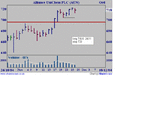Yes, and very much appreciated all the work, I will no doubt read it again now! 😆
I do look at volume, and use it as a guide to the price action, but like others I am very much an apprentice in the art of volume interpretation.
Thanks to others too, such as sulong and porks.
Q
I do look at volume, and use it as a guide to the price action, but like others I am very much an apprentice in the art of volume interpretation.
Thanks to others too, such as sulong and porks.
Q



